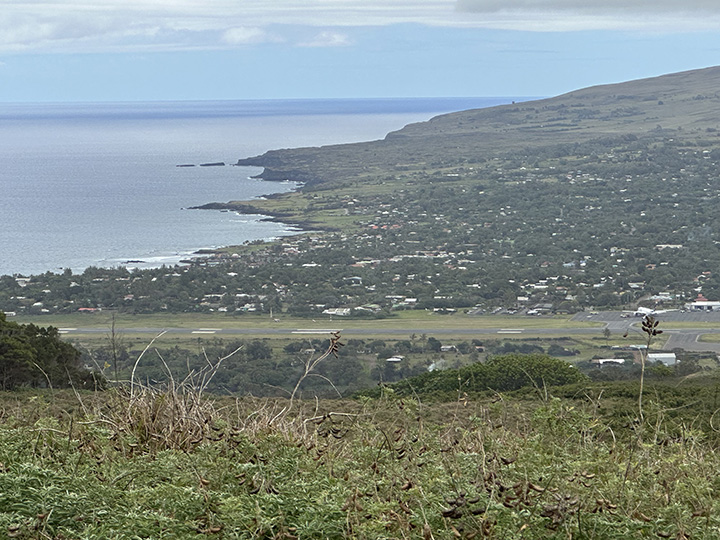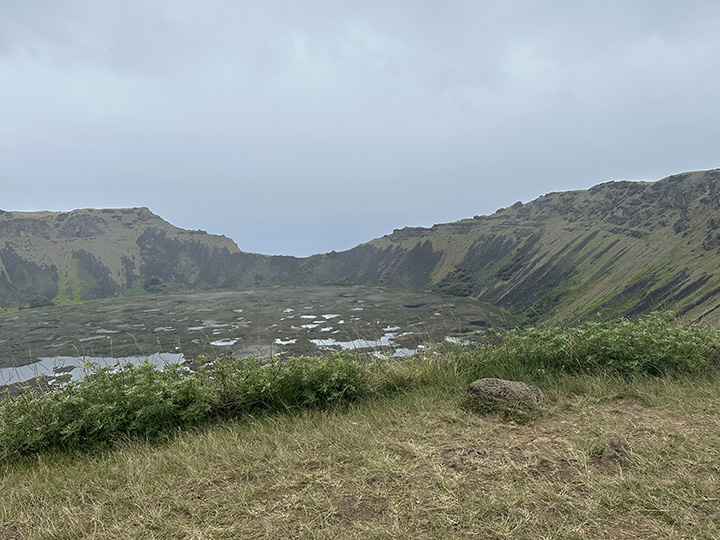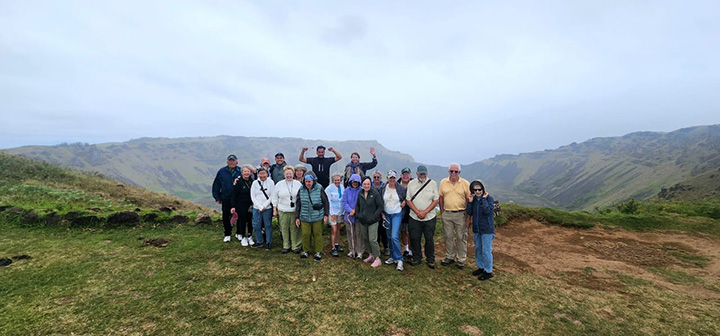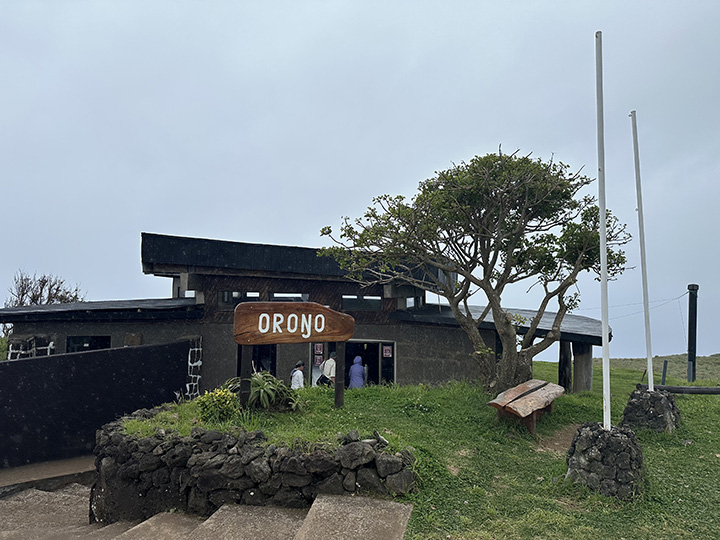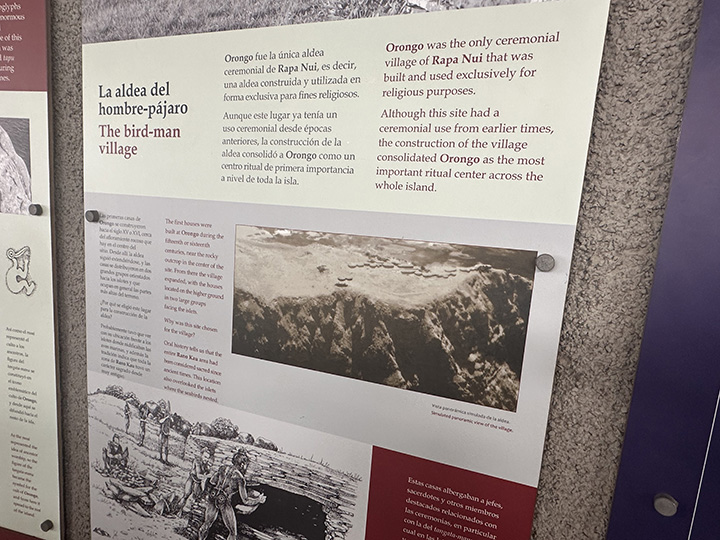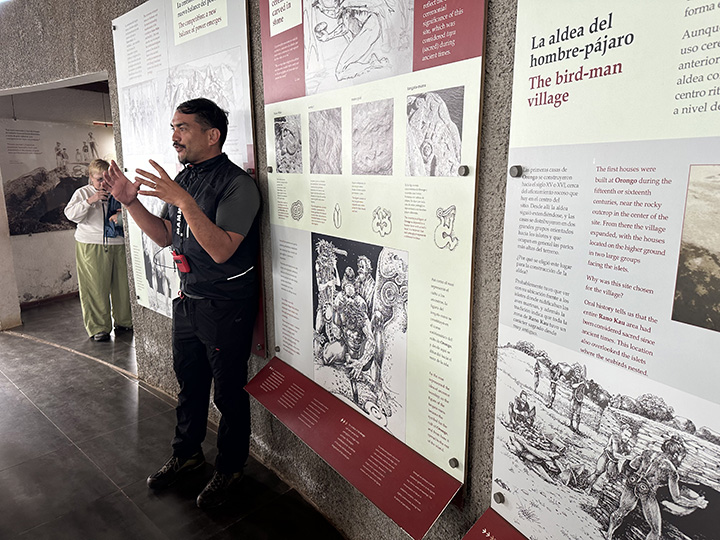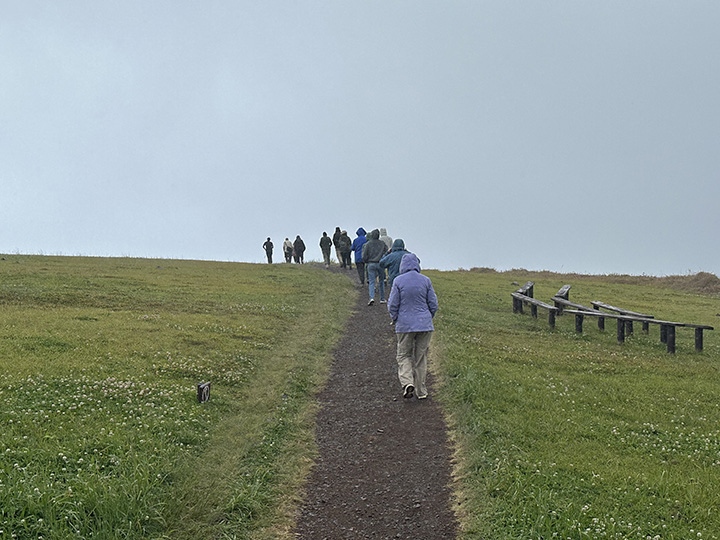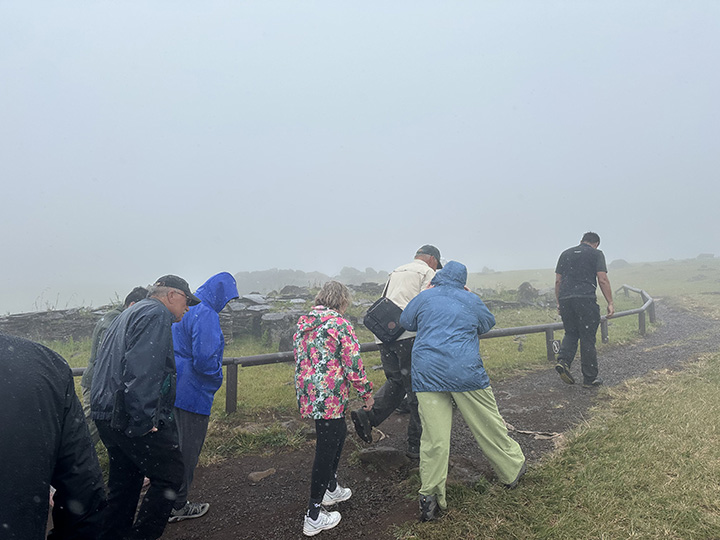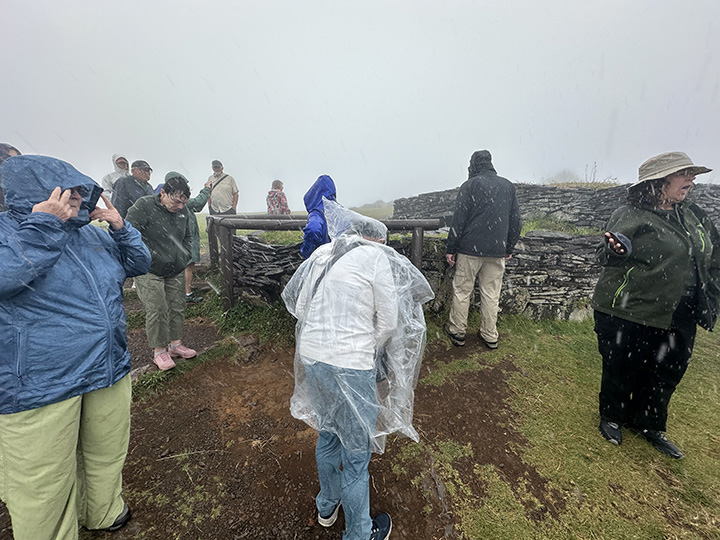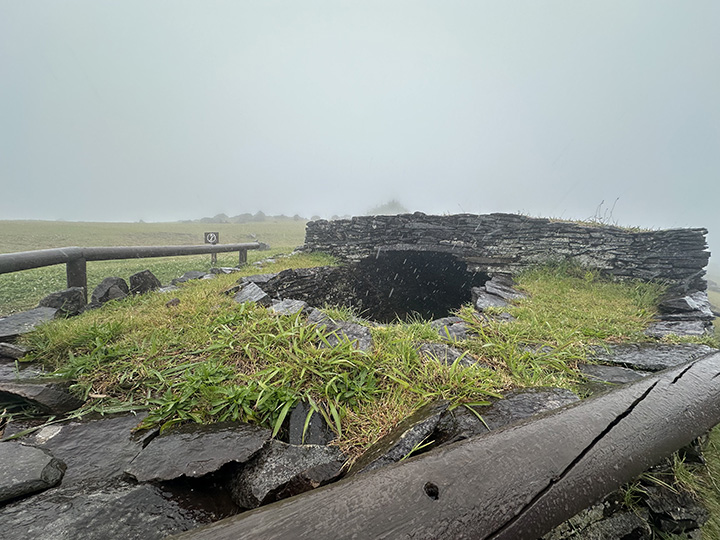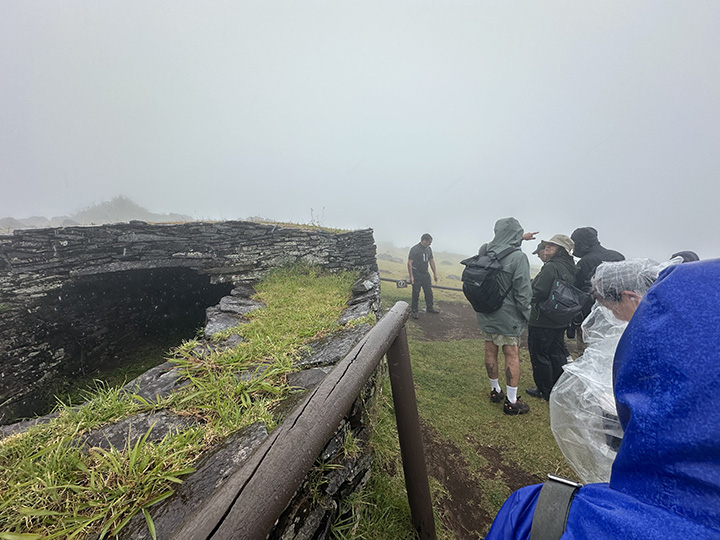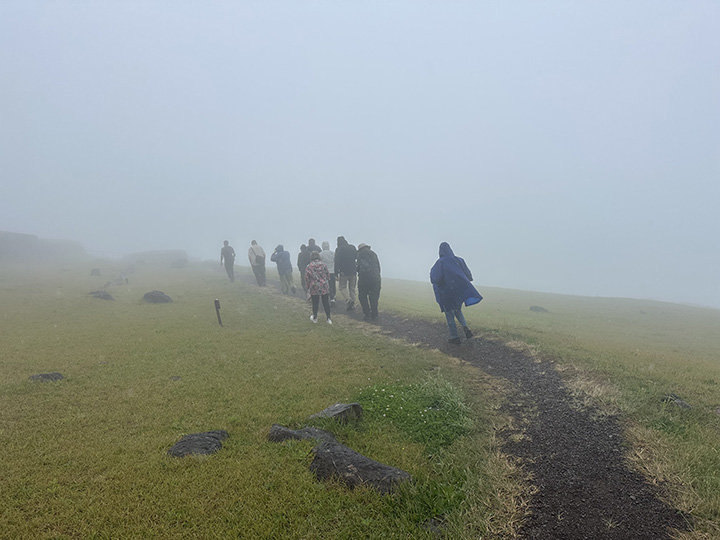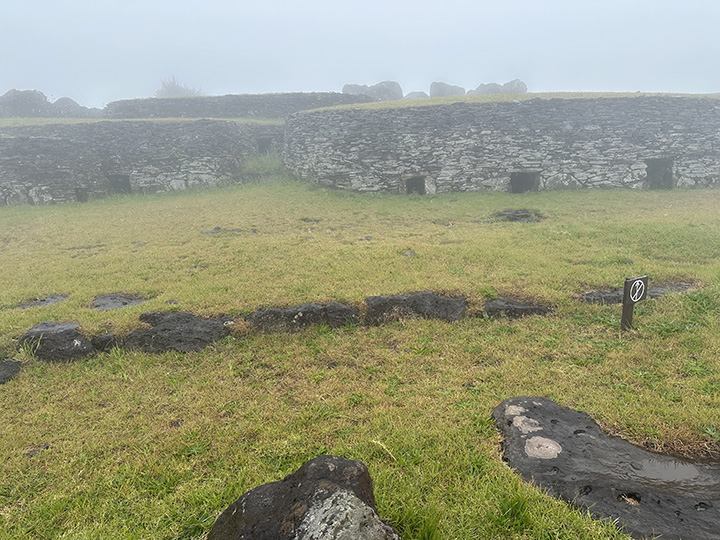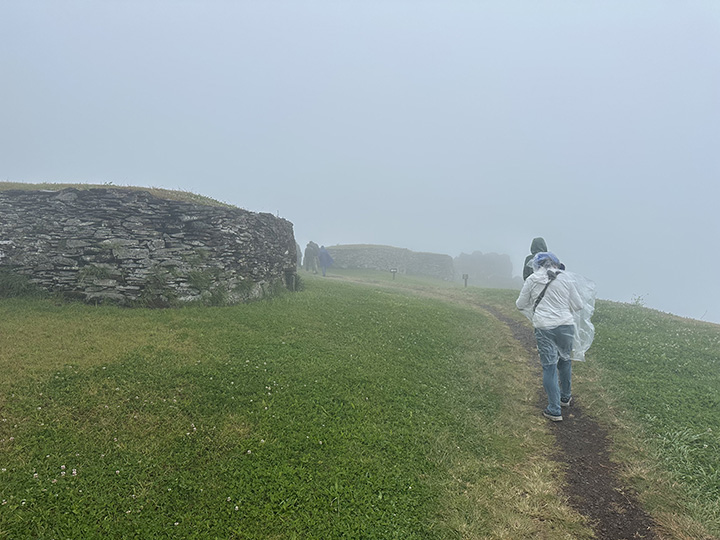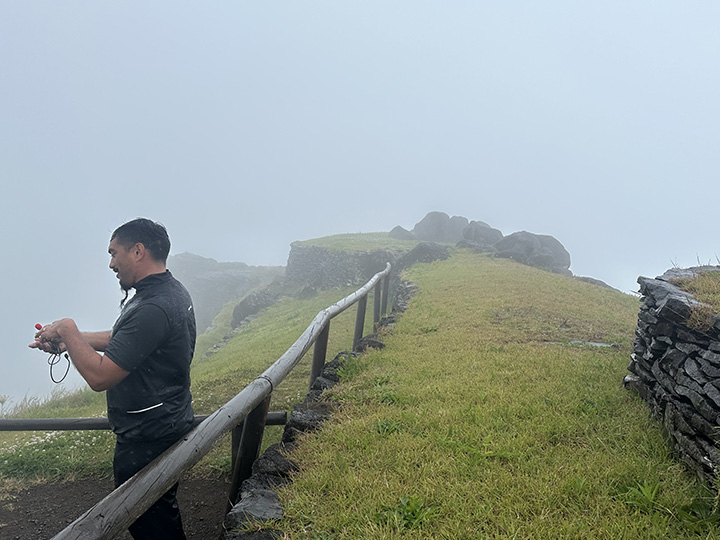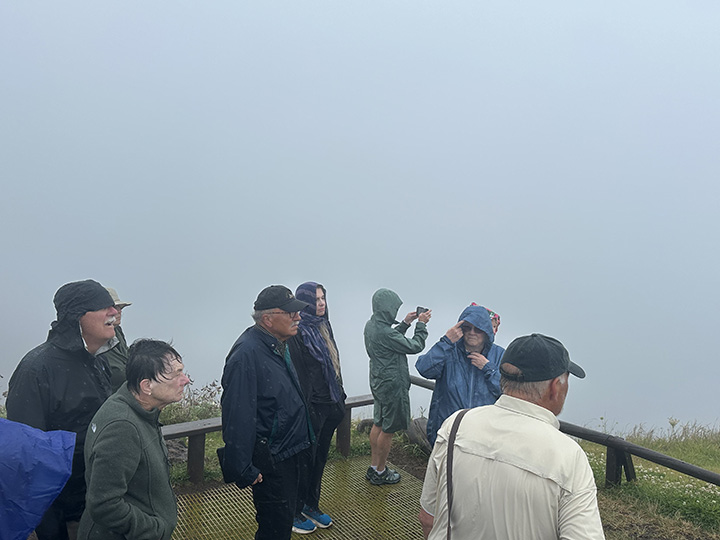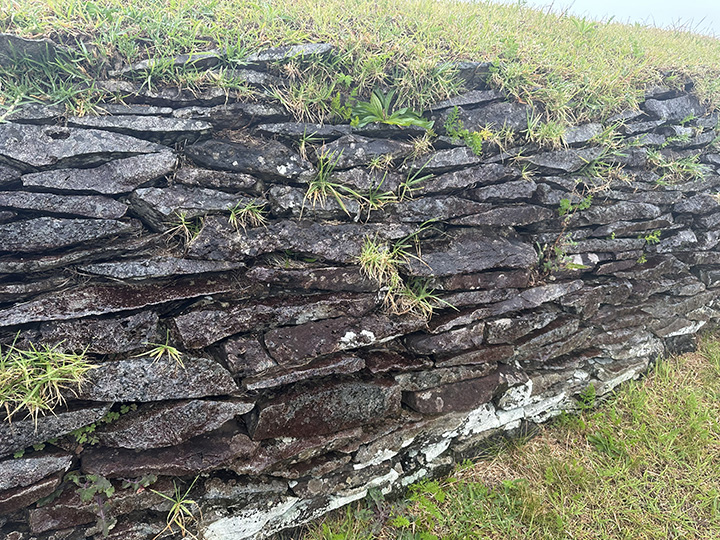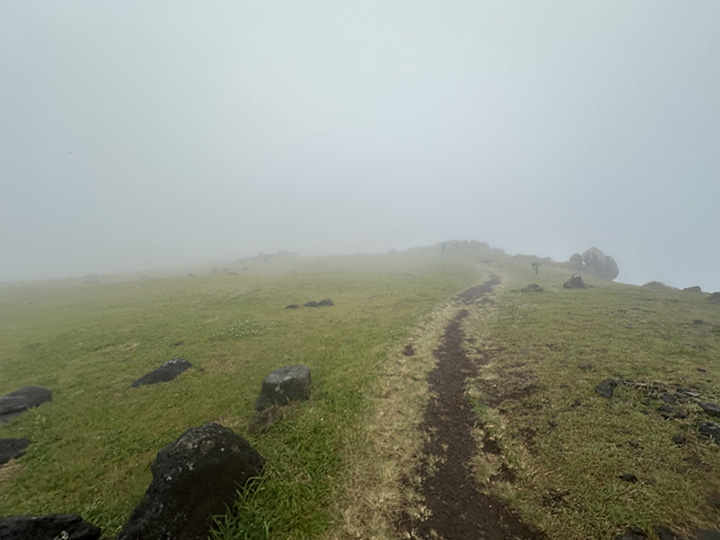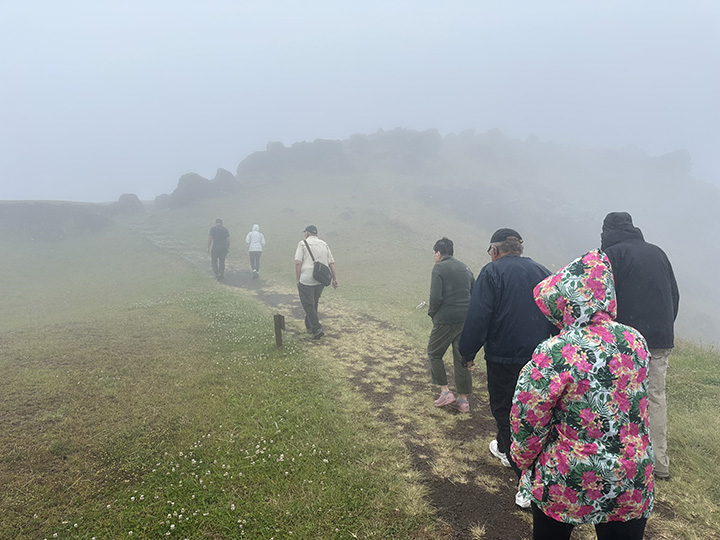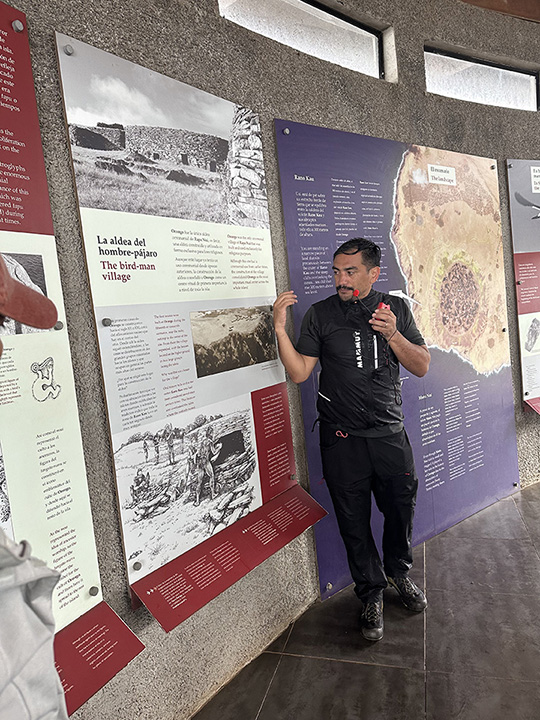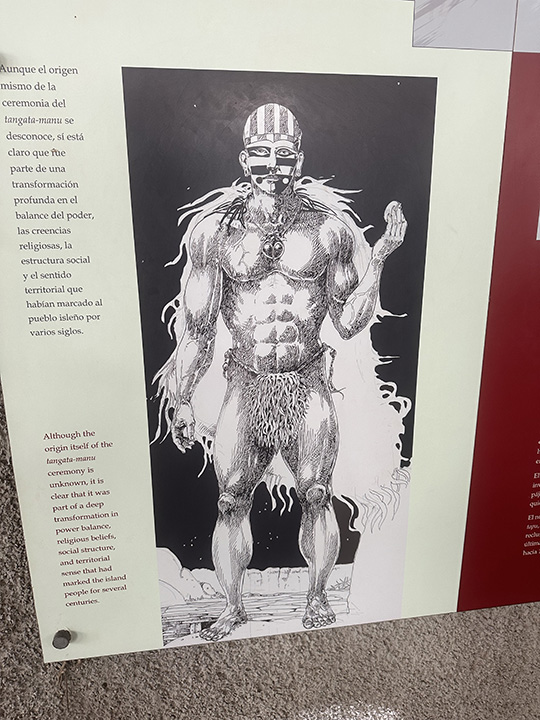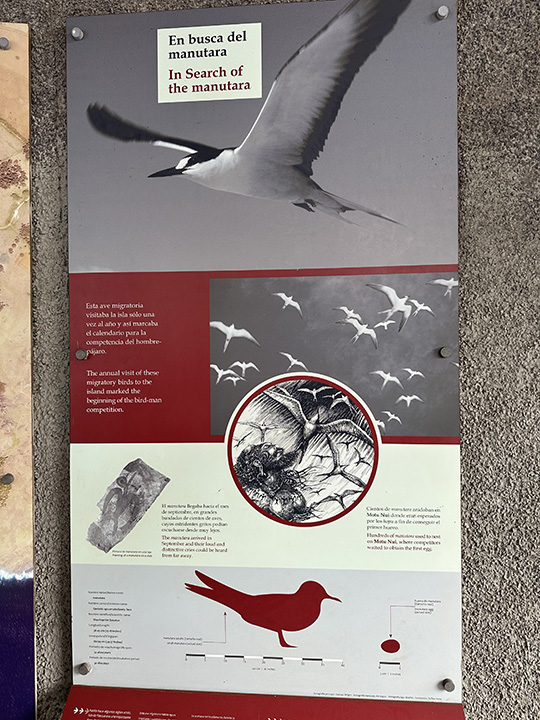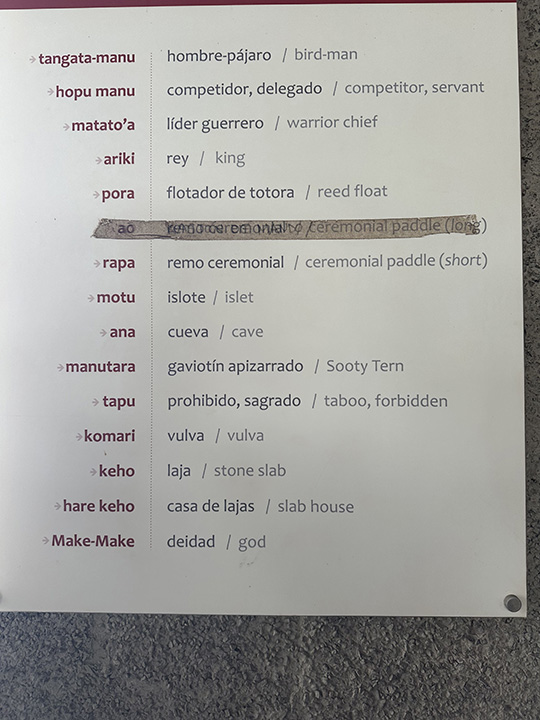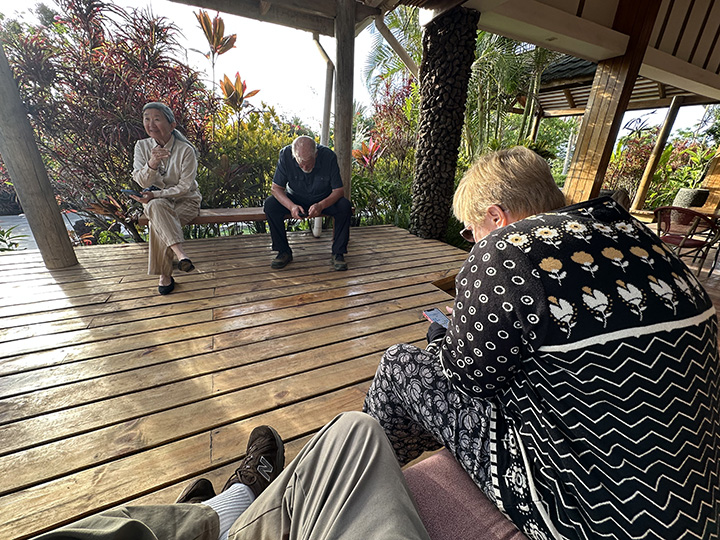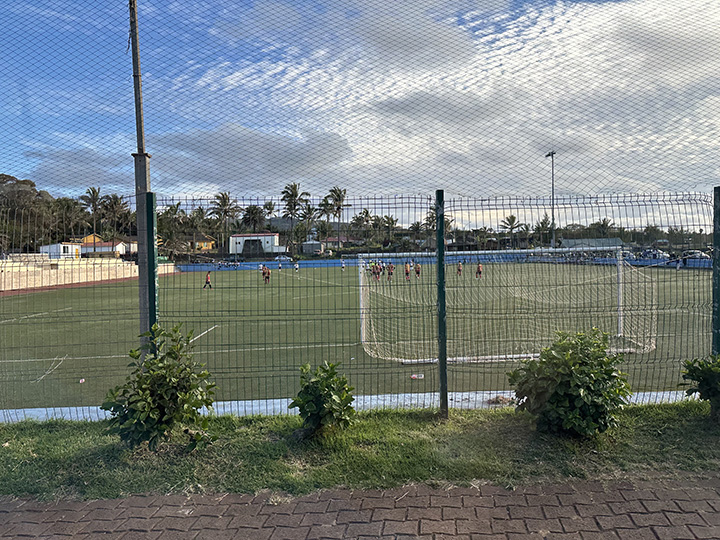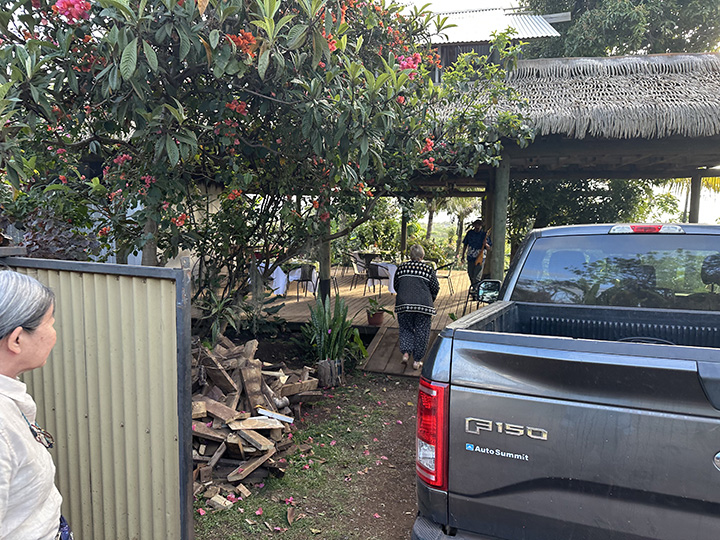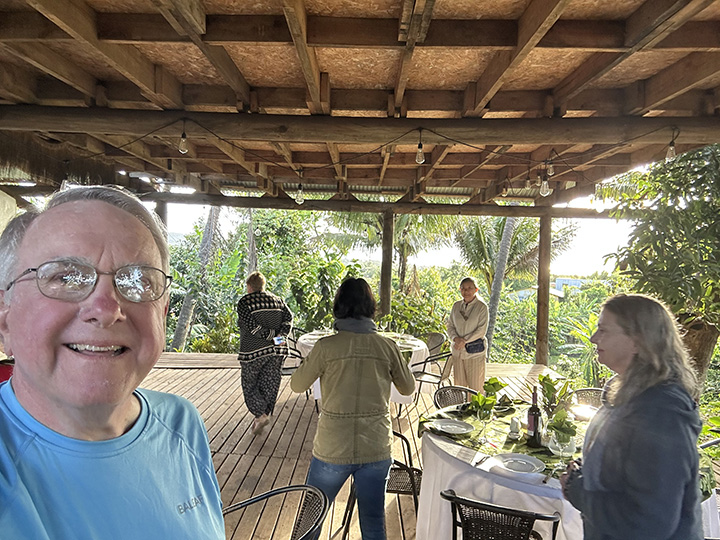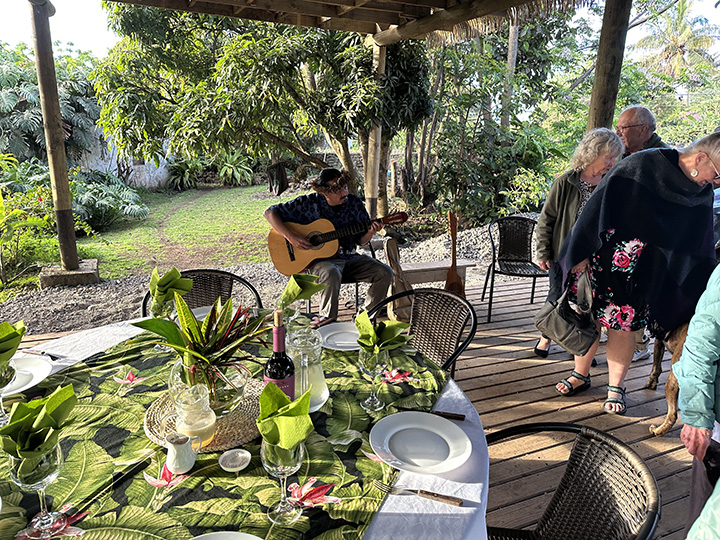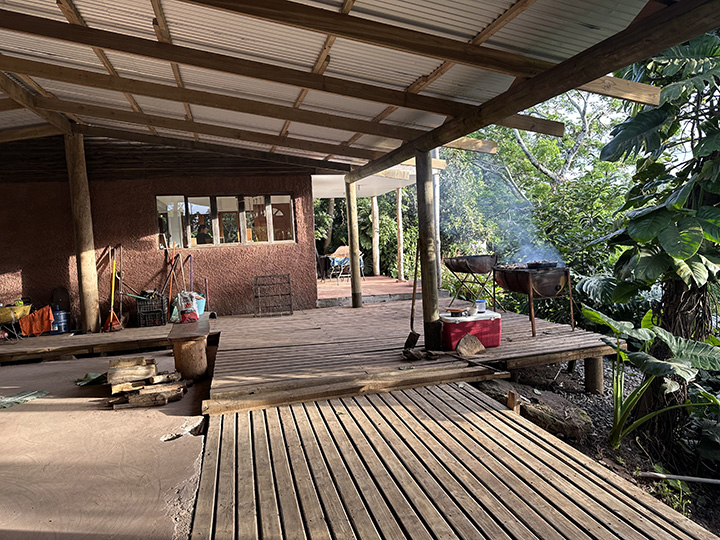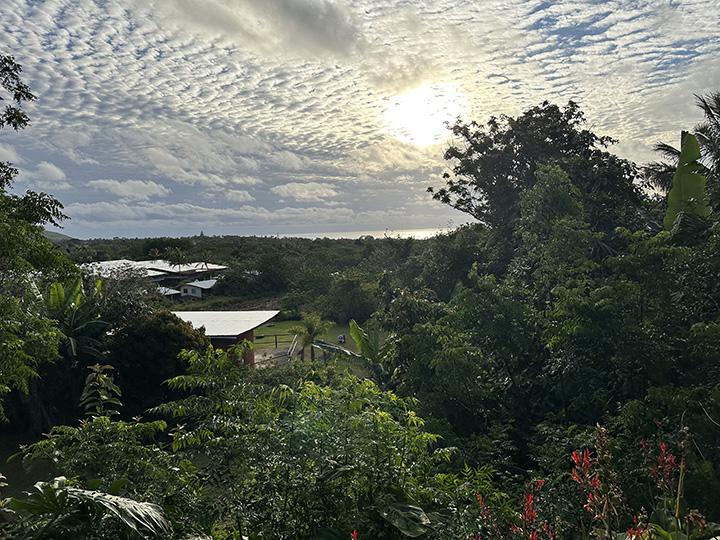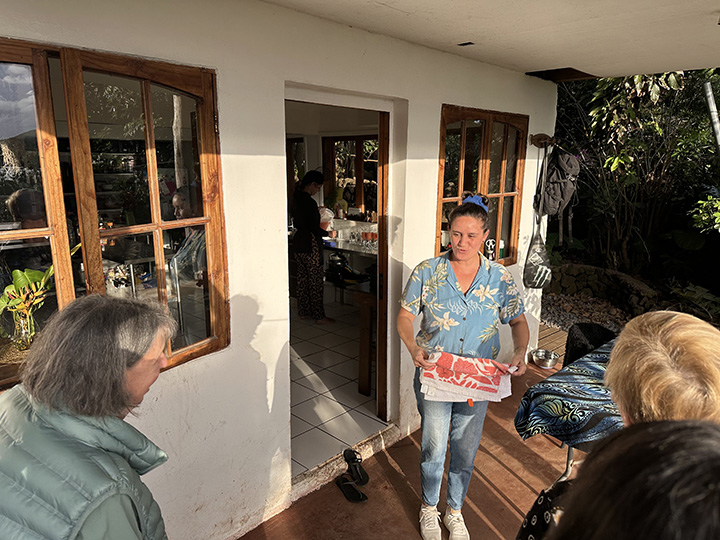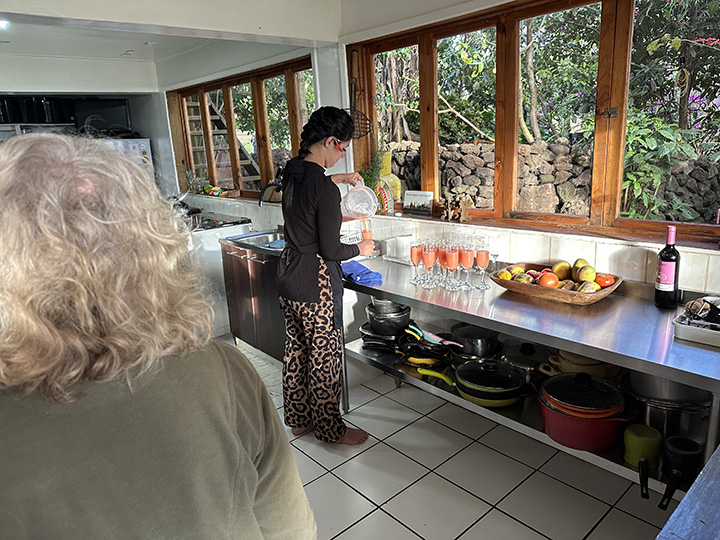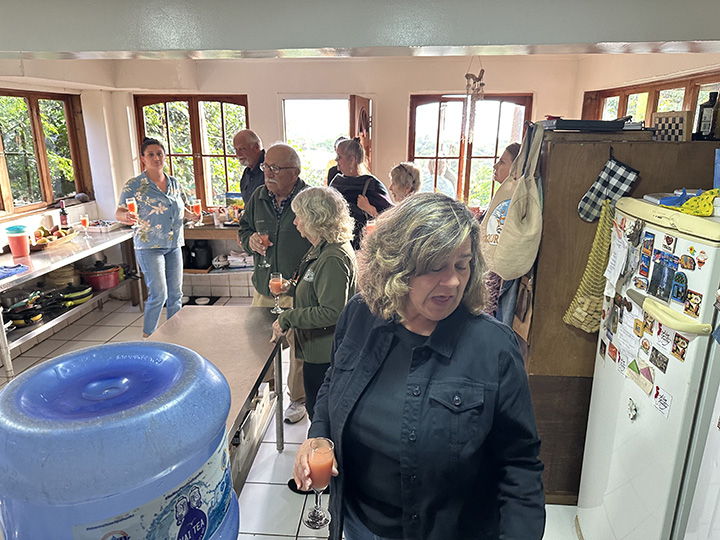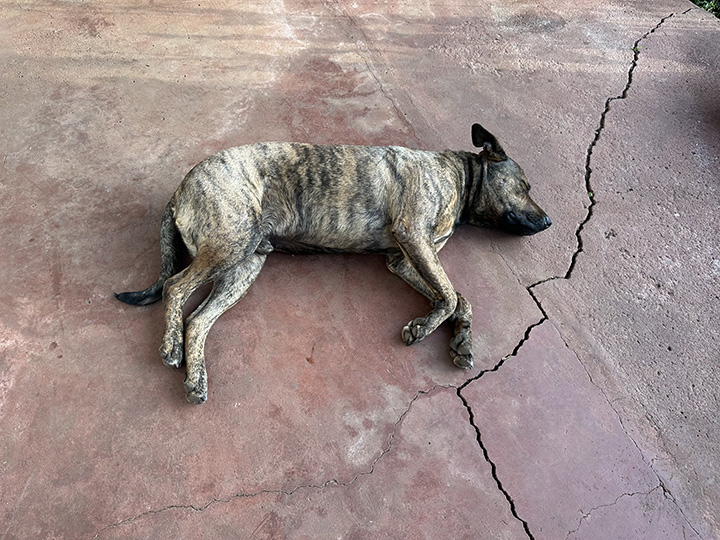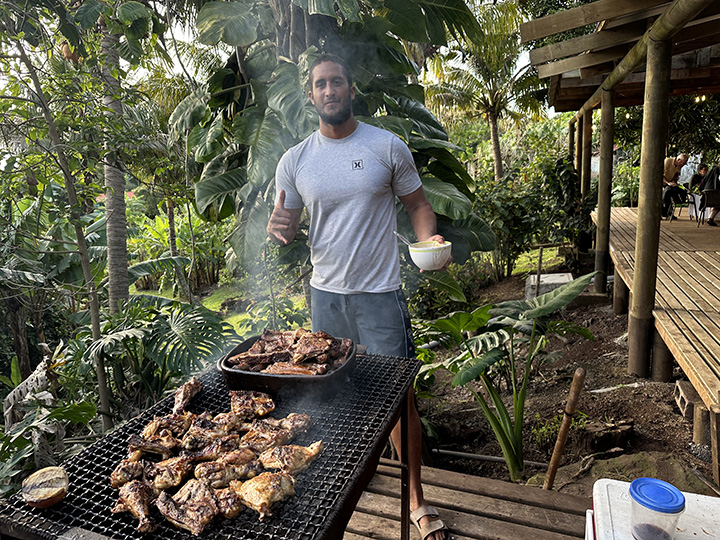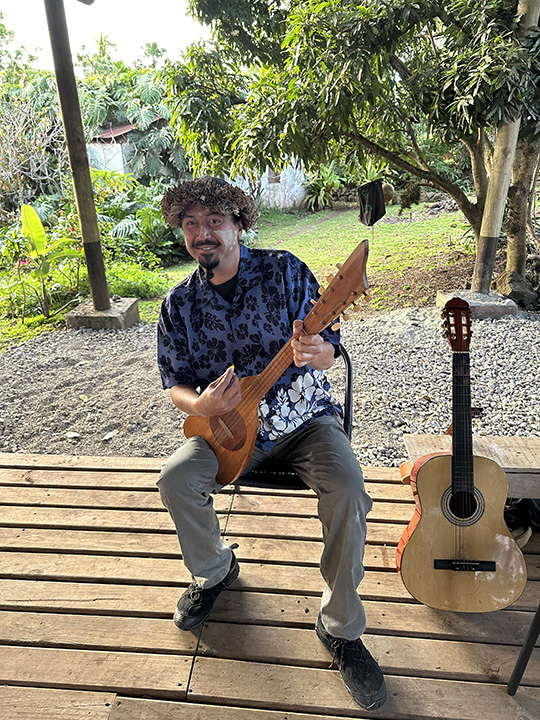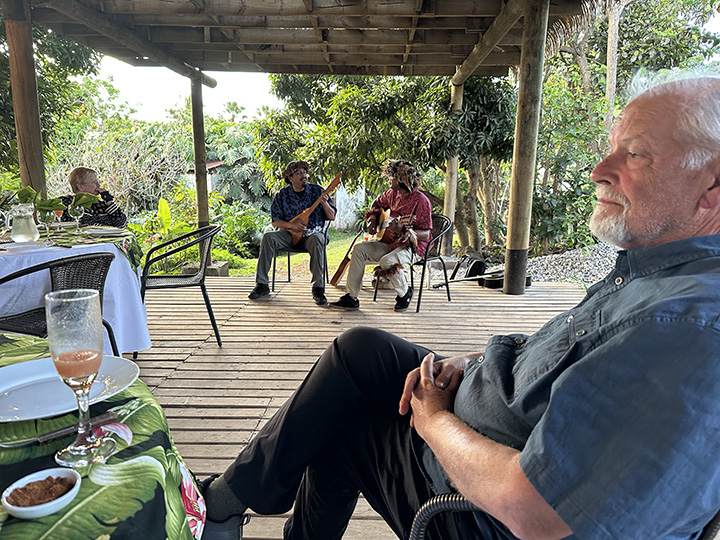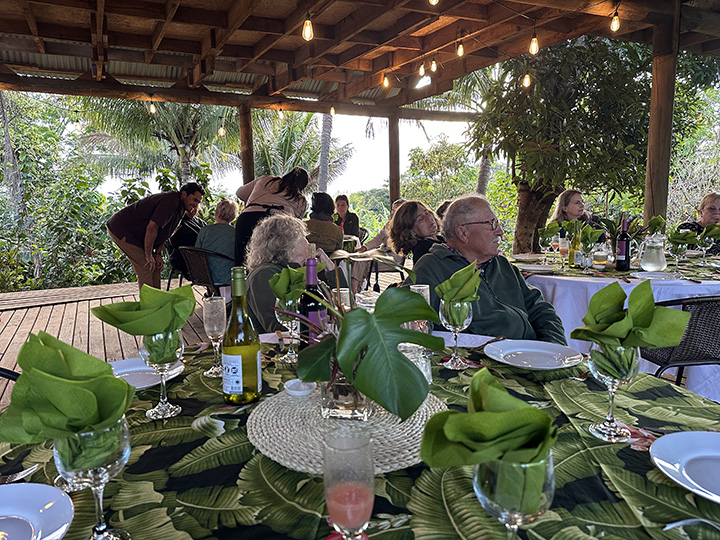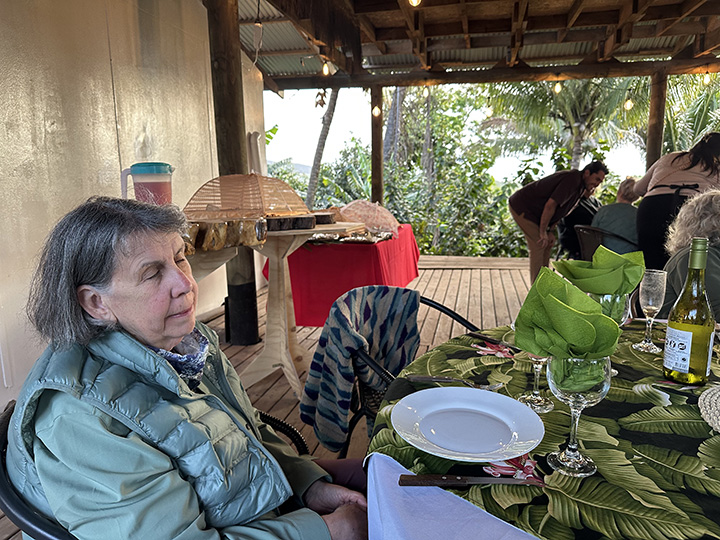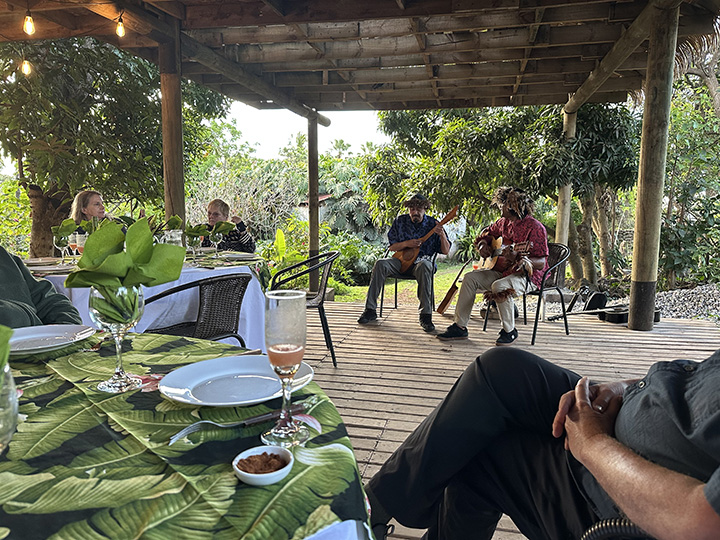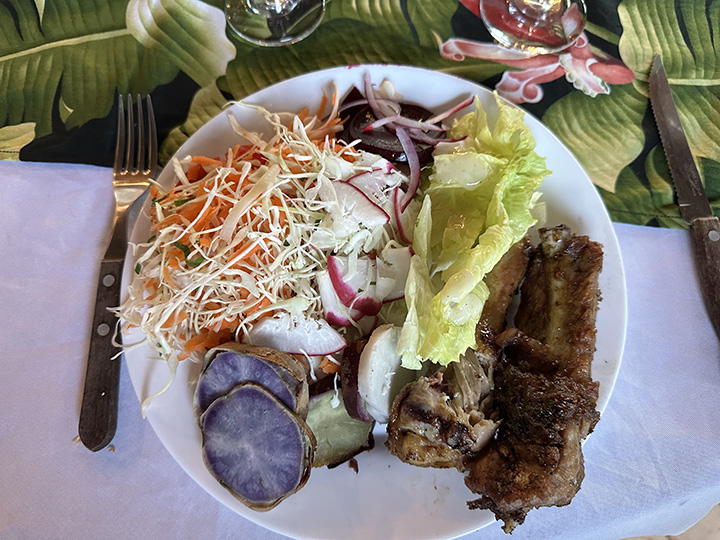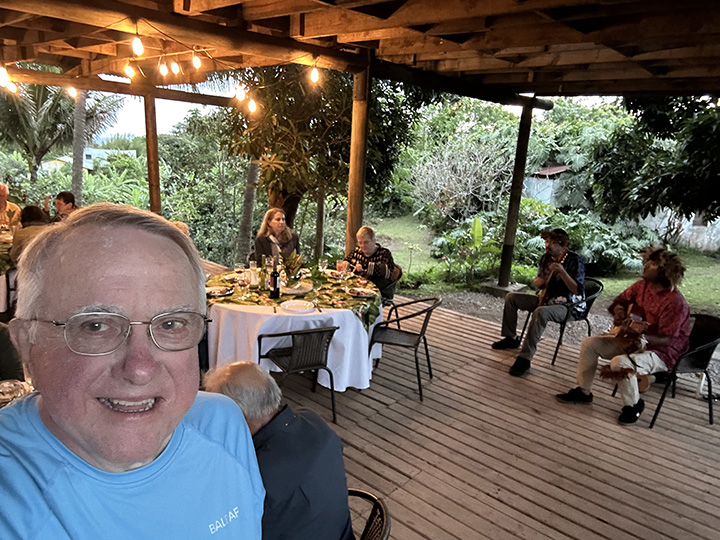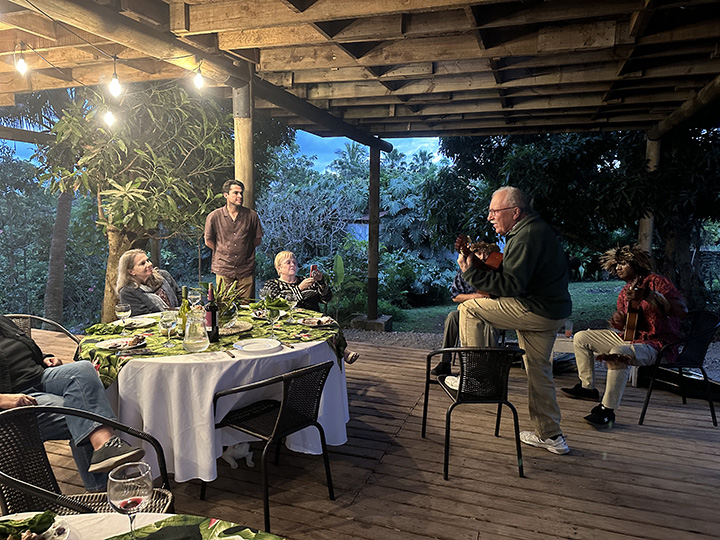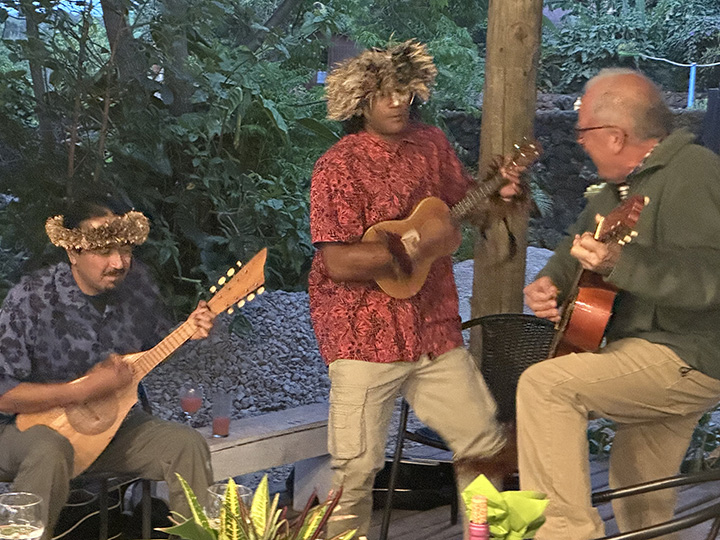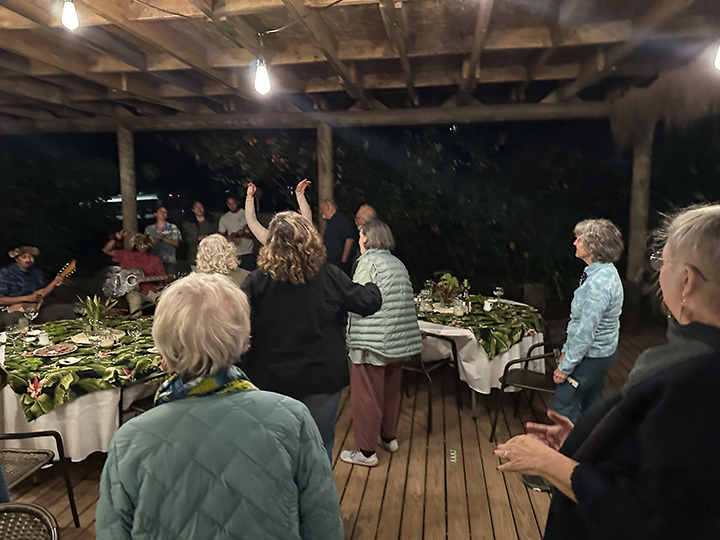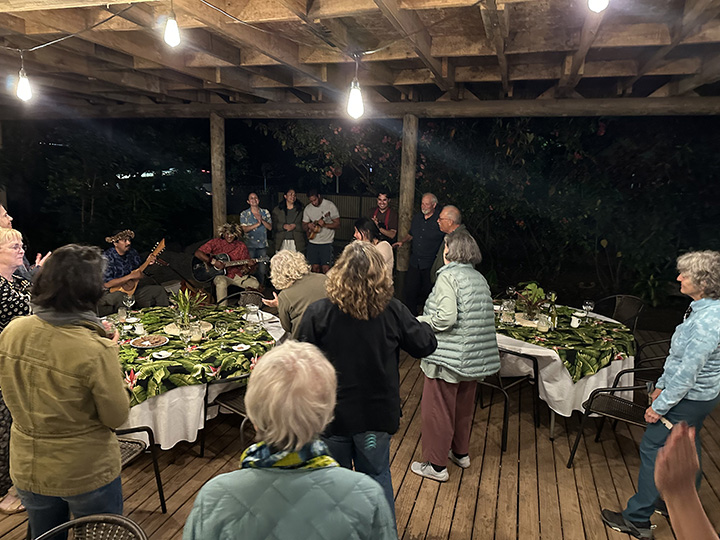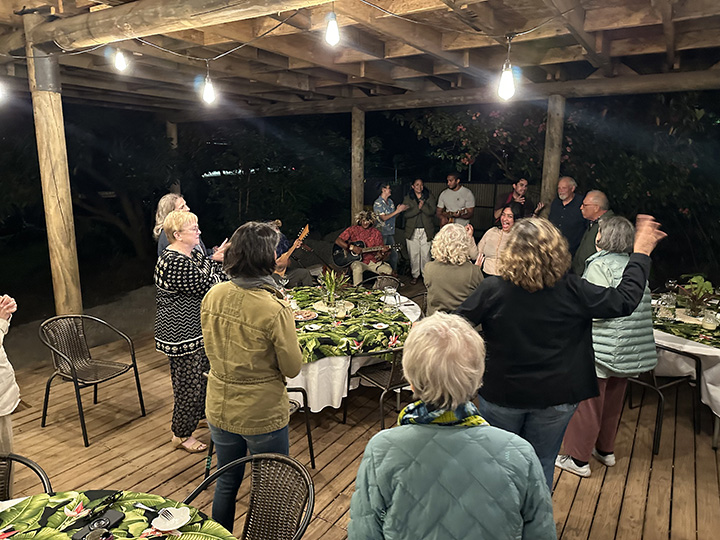|
We had a lot of free time today and I spent most of it just relaxing in my room. I know that’s not how you are supposed to spend a vacation, but my legs have been telling me they need to rest. So rest is what they got today. However, when they weren’t resting, they were busy helping me have a great time. It was a good day and it ended on a very high note. In fact, if I were forced to pick my favorite day of the trip, in spite of a brief weather intrusion, this would probably be it.
I began to feel guilty about all the rest, so I did go on a short walk. This is a local city park.
It has statues of important people.
It's a pleasant place.
It's Sunday morning and the Catholics are leaving mass.
The dogs are enjoying the sunshine.
You'd think on a lazy Sunday morning there wouldn't be much traffic but I learned pretty quickly always to look both ways before even thinking about stepping off the curb.
Let's go exploring again.
We have driven up Rano Kao volcanic crater. Here's what Wikipedia says about it: Rano Kau is a 1,063 ft tall extinct volcano that forms the southwestern headland of Easter Island. It was formed of basaltic lava flows in the Pleistocene with its youngest rocks dated at between 150,000 and 210,000 years ago. Rano Kau has a crater lake which is one of the island's only three natural bodies of fresh water. The lake is located approximately 330 ft above sea level, but is more than 660 ft below the highest of the crater's ridges. The volcanic cone is largely surrounded by water, and much of it has been eroded back to form high sea cliffs which at one point (te kari kari) have started to bite into the crater wall. The inside walls of the crater are sloped at an angle of between 65° (steepest, near the crest) and 45° (gentlest, at the lake shore). From the ruins of the ceremonial village of Orongo the cliff face drops to the southwest at an angle of 50° to the sea shore some 980 ft below. On its northern side, the volcano slopes down to Mataveri International Airport. Rano Kau is in the World Heritage Site of Rapa Nui National Park and gives its name to one of the seven sections of the park. The principal archaeological site on Rano Kau is the ruined ceremonial village of Orongo which is located at the point where the sea cliff and inner crater wall converge. One ahu with several moai was recorded on the cliffs at Rano Kau in the 1880s, but had fallen to the beach by the time of the Routledge expedition in 1914. The crater is almost a mile across and has its own micro climate. Sheltered from the winds that wet most of the rest of the island, figs and vines flourish at Rano Kau. The inner slope was the site of the last toromiro tree in the wild until the specimen was chopped down for firewood in 1960.
That’s a freshwater lake down there in the crater of the volcano.
There once was a moai up here but in 1868 it was stolen by the British and now it's in the British Museum in London. You can read about it in Wikipedia.
Cristian is explaining what we see.
He's really good at this.
He said the lake is covered with floating patches of reeds that can actually be walked on. Cristian told us that he and his brother used to go down there and swim. He says there are many tiny little fishes in the lake that were introduced in order to reduce the mosquito population. He says it’s the only place on the island where a species alien to the island have been introduced to good effect. He says that when you swim in the water the fish nibble on you and it tickles.
I will take his word for it.
He says that local people go down there to collect plants that are used in holistic medicine.
Numerous people.
The ancient people on the island conducted annual ceremonies up here. That’s a petroglyph carved into the rock.
Some of the rock art appears to refer to status, some to clan identification; others were offerings or supplications, some marked the location of special rites and ceremonies, and some were related to the esoteric and religious aspects of the society. Bird Komari Birdman Motifs Rock Art Petroglyphs Easter Island Rapa Nui Archaeology Aside from the monolithic statues, the birdman image best represents Rapa Nui. This distinctive motif, with its huge eye and bird beak combined with a crouching human figure in profile, dominates the petroglyph site of Orongo. There are 1,274 documented petroglyphs, nearly all of them the birdman motif, clear evidence of Orongo's association with the Rapa Nui birdman ceremony.
See the airstrip down there? Nice, right? Back in the 1980s the airport on Easter Island was improved and extended by NASA to serve as an emergency landing site for Space Shuttles that were going to be launched from Vandenberg Air Force Base in California. The first launch was planned for March, 1986, but in January, 1986, the Space Shuttle Challenger exploded upon launch at the Kennedy Space Center in Florida and all plans for launches from California were first put on hold, and eventually abandoned. Here's a Los Angeles Times article from 1985 that tells the story of how the landing strip came to be.
So everybody has walked up a hill to get a better look. Guess I'll join them and get a good panoramic video of the area.
Hey guys, don't leave me!
Thank goodness they waited for me to get back down the hill before they took what turned out to be our only group photo of the trip.
Now we have arrived at the Orongo Village visitor center. Wikipedia says: Orongo (Rapa Nui: Oroŋo) is a stone village and ceremonial center at the southwestern tip of Rapa Nui (Easter Island). It consists of a collection of low, sod-covered, windowless, round-walled buildings with even lower doors positioned on the high south-westerly tip of the large volcanic caldera called Rano Kau. Below Orongo on one side a 300-meter barren cliff face drops down to the ocean; on the other, a more gentle but still very steep grassy slope leads down to a freshwater marsh inside the high caldera.
Orongo is the site of the bird man village, the only place on Rapa Nui known to have been used for religious ceremonies.
Cristian began telling us the fascinating story of Rapa Nui's Birdman cult, but suddenly the rain started pouring outside and this area became filled to capacity with wet tourists. Of course we couldn't hear Cristian above the hubub..
But we would not be deterred. We are here to learn! So the Road Scholars bravely followed their leader out into the cold and rain.
It wasn't really a downpour -- just a miserable drizzle. Poor Cristian didn't have a coat but he kept telling us he loves weather like this. Ahhh...so refreshing!
The Road Scholars are feeling oh so very refreshed.
But through the cold mist they did manage to see some interesting remnants of the days when Orongo Village was central to Rapa Nui society.
From Wikipedia: The first half of the ceremonial village's 53 stone masonry houses was investigated and restored in 1974, with the remainder completed in 1976 and subsequently investigated in 1985 and again in 1995. Orongo now has World Heritage status as part of the Rapa Nui National Park.
The Road Scholars are having a little trouble detecting the World Heritage site which they have been told is up there somewhere.
Ah, there it is.
And we are going to see it even if we all die of pneumonia.
Cristian's Whisper got wet and stopped working.
But if we gathered 'round we could still hear him.
He explained how the Rapanui people didn't have much wood for building materials but they had plenty of volcanic rock so they built with what they had.
I believe the relatively warm and dry visitor center is over that way somewhere.
Let's go.
Finally the tourists got back on their bus and left us in peace. Now Cristian can return to telling us about the Birdman and his cult.
And that's the Birdman. Impressive, right? I'm going to do my best to repeat Cristian's story about all this based on my memory and details gleaned from Wikipedia. In long ago times, up until the mid-1860s, Rapanui society consisted of a number of individual clans that populated small villages spread out across the island. Each clan had its own king who made decisions for his people. But some issues affected the entire island so the people instituted a king over all the other kings who became known as the Tangata Manu, or Birdman. The Birdman was all powerful on the island and venerated to such a degree he was considered "tapu" (taboo). The people appointed to serve him wouldn't even look at him. He was expected to lie on his bed in a cave where he was brought food and drink and was otherwise fearfully attended to, but basically he led a lonely existence when he wasn't issuing orders. Everybody had to do whatever the Birdman said to do, but his orders were generally in the island's best interest. He didn't become a megalomaniacal tyrant because his term as the Birdman lasted only one year. (It wouldn't be smart to make everybody mad at you if someday soon you'd go back to your old life.) The Birdman got his name from the way he was selected. Each of the island's kings would pick a strong, athletic young man (hotu) to represent him in a competition to collect the first sooty tern (manu tara) egg of the season from the nearby tiny island of Motu Nui. The hotus had to climb down the sheer cliff at Orongo to the ocean, swim out to Motu Nui while dodging sharks along the way, find shelter on the island and live there for days or weeks until the migrating sooty terns began showing up, and be the first to steal an egg from a bird's nest.
Once the first egg was collected, the finder would go to the highest point on Motu Nui and call out to the shore of the main island, announcing his benefactor by the benefactor's new name and telling him, "Go shave your head, you have got the egg!" The cry would be taken up by listeners at the shoreline, who would pass it up the cliffside to the contestants waiting in Orongo. The unsuccessful hopu would then collectively swim back to the main island while the egg-finder remained alone on Motu Nui and fasted; he would then swim back with the egg secured inside a reed basket tied to his forehead. On his reaching land, he would then climb the steep, rocky cliff face and present the egg to his patron. This successful contestant – not the hopu, but his sponsor – would then be declared the new tangata-manu, and would take the egg in his hand and lead a procession down the slope of Rano Kau to Anakena (if he was from the western clans) or Rano Raraku (if he was from the eastern clans). The new tangata-manu was entitled to gifts of food and other tributes and his clan would have sole rights to collect that season's harvest of wild bird eggs and fledglings from Motu Nui. He then would go into seclusion in the cave and become Birdman for a year. The bird-man cult was ended by Cristian missionaries in the 1860s.
Want to practice your Rapanui?
Now we've returned to Hotel Otai and we're waiting for a bus to take us to dinner.
It's been quite a day. Can anything be as interesting as what we've seen so far?
It's that soccer field again. There seems always to be a game in progress over here.
We have arrived at the home of Tarin Pakamio Paoa and family.
They run a catering business and they've set up their home to accommodate sizable groups of guests. Road Scholar has arranged for them to host us tonight.
We feel immediately welcome.
There's live music!
Is that food on the grill over there?
I'll say that's food on the grill. Wow and oh boy!
There's a very nice view from up here.
Anybody want to tour the kitchen?
Some delicious punch for the Road Scholars.
The party is getting started.
The family pooch is certainly excited by all the visitors.
Patience, my friend. We'll eat soon.
Island music!
These guys were great.
Tom is certainly enjoying this.
What a lovely evening it was.
Wake up, Andrea.
OK, time to eat.
Dinner was fantastic. That is a big grilled pork rib and there was grilled chicken and tuna and taro and green salad and slaw and raw fish with special sauce to pour on top and sweet potato and other stuff I didn’t know what was. I savored every bite.
I was loving this
John surprised the musicians by joining in. They had been playing island music and he taught them to play along as he sang “Wagon Wheel.” This was so much fun!
John taught the islanders how to play country/western.
They really got into it.
Now it's time for the Road Scholars to party. But first a little dance instruction.
This is turning into a real party.
Don't ever let anybody tell you the Road Scholars don't know how to have fun.
More dancing.
And more.
Lesson learned: be sure not to be setting up the iPhone camera after you've started taking video. Anyway, this longish video shows Bill discovering he's been left behind while almost everybody else walked across the street to a sculptor's studio.
That wasn't enough fun for the Road Scholars so the party continued on the bus back to the hotel. This turned out to be one terrific day all around.
|

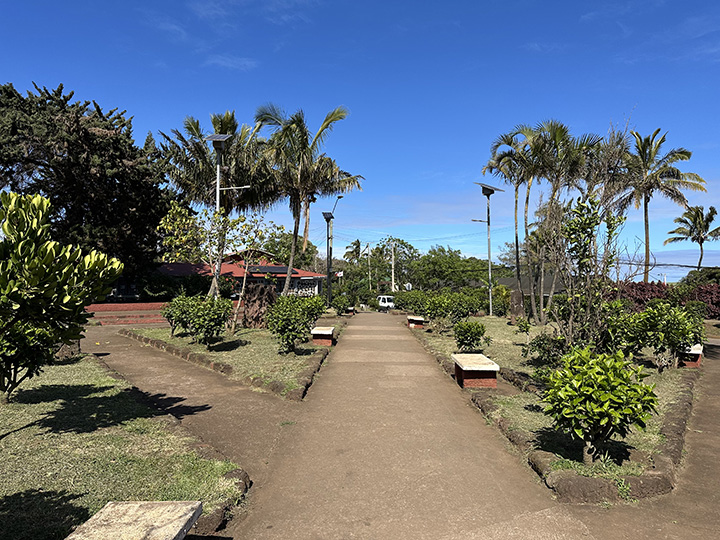
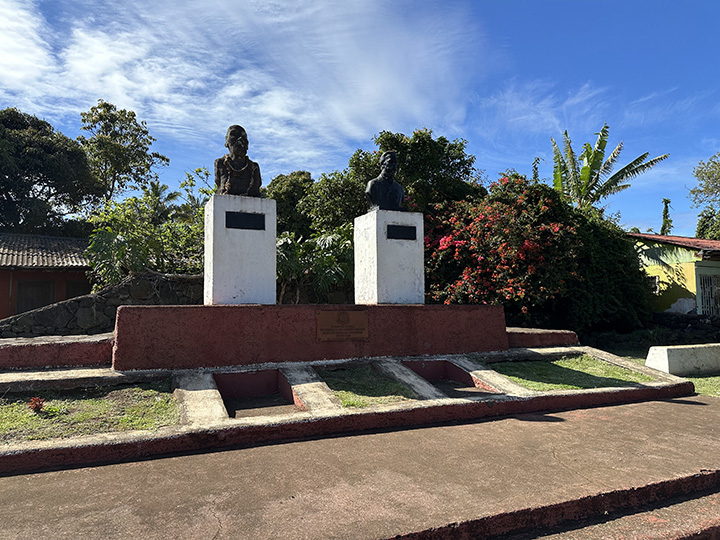
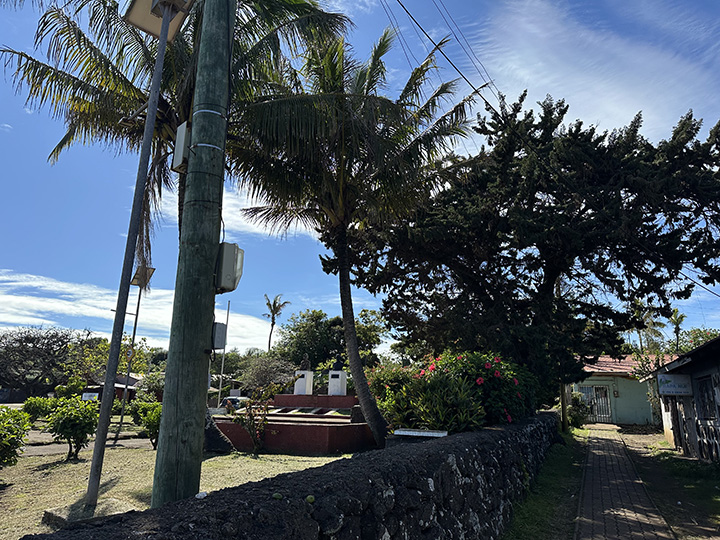
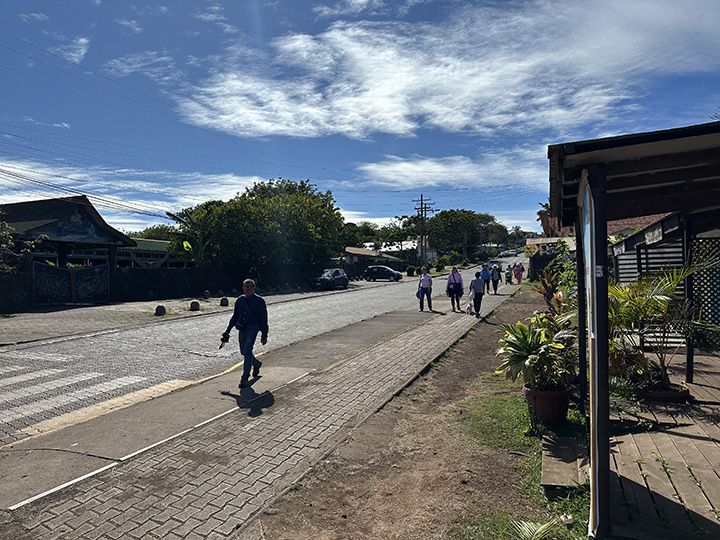
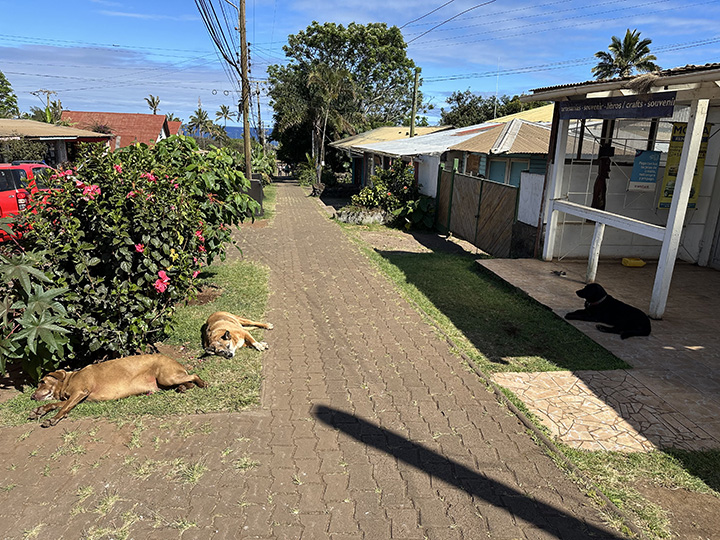
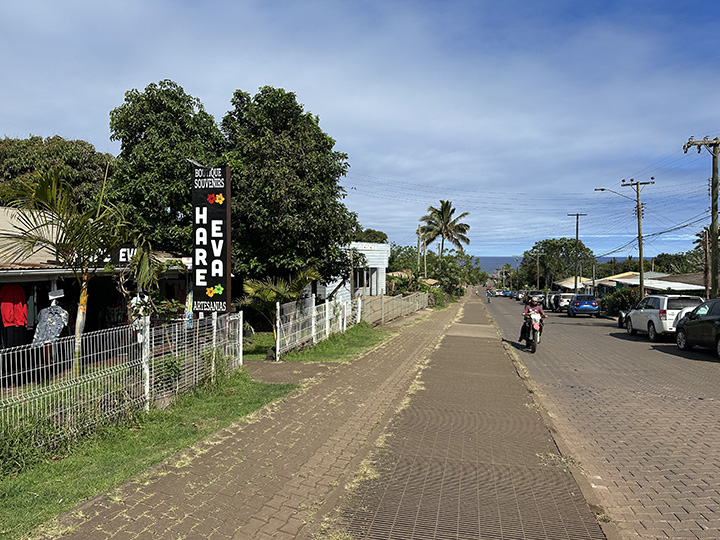
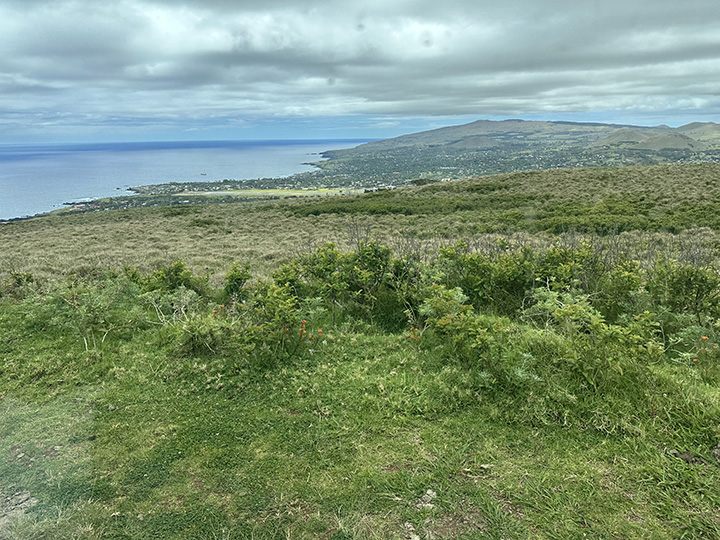
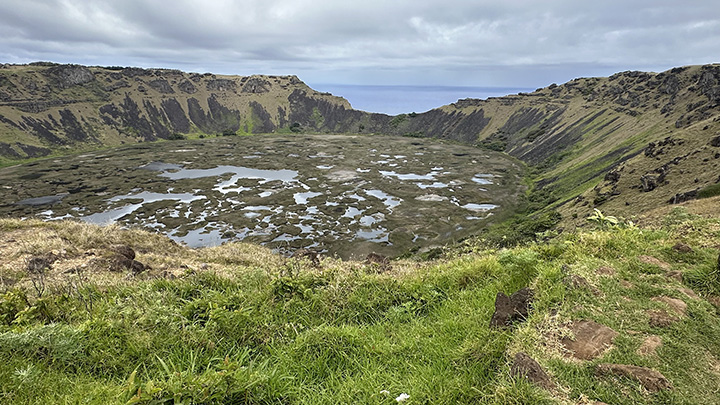
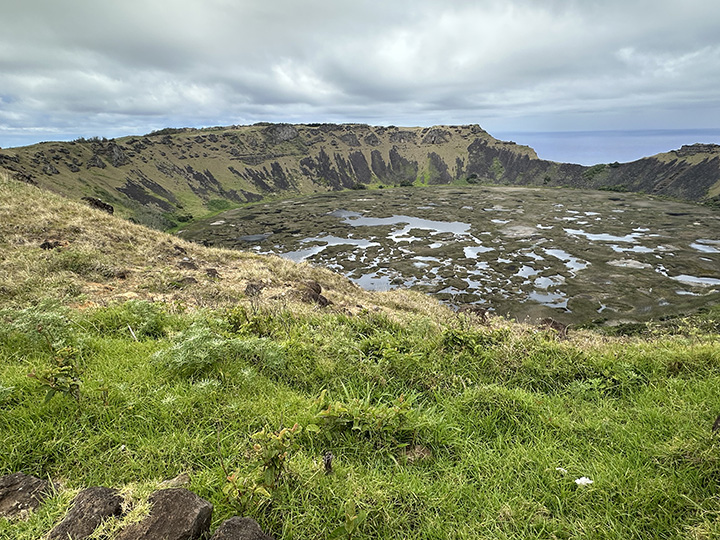

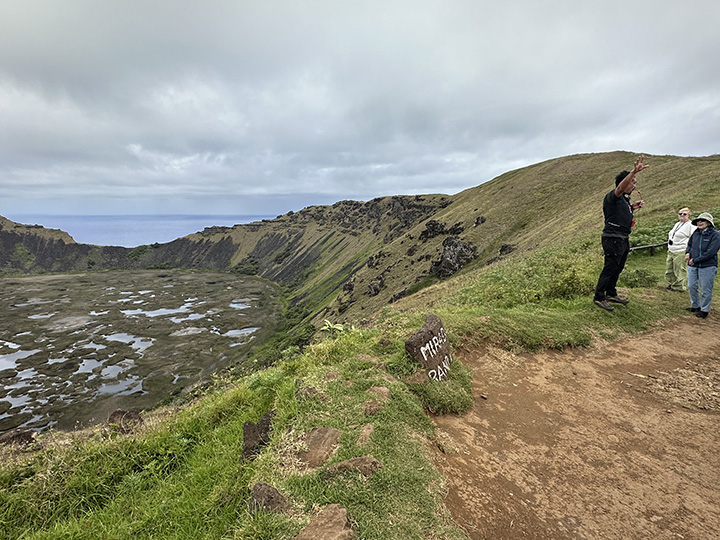
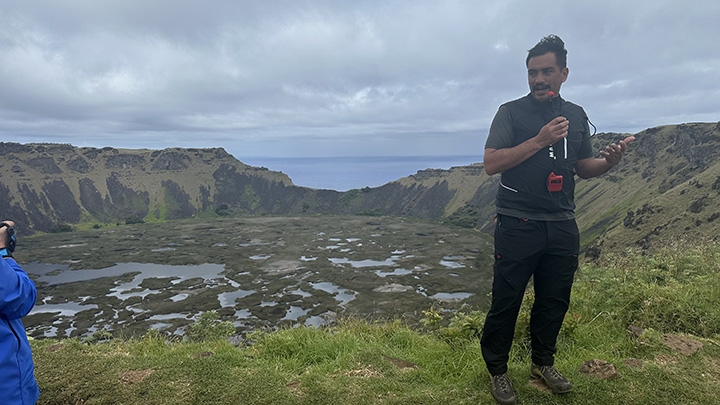
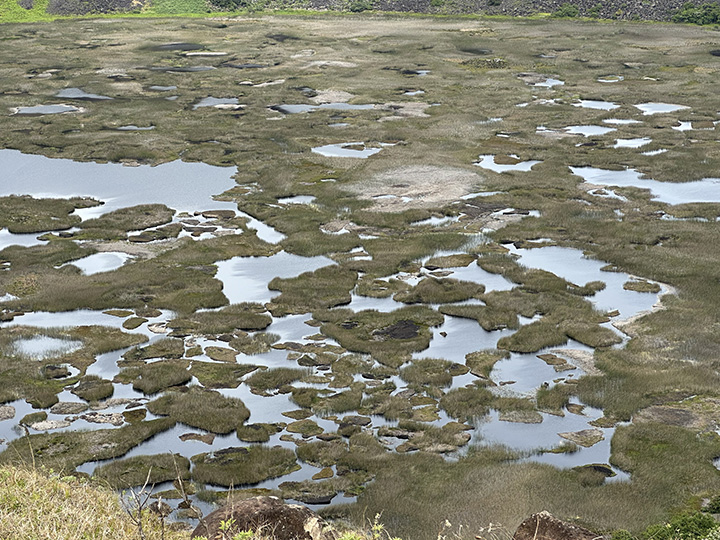
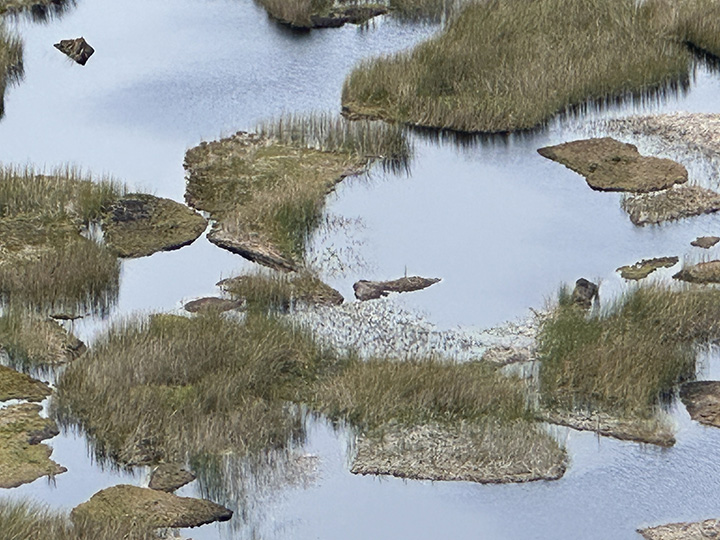
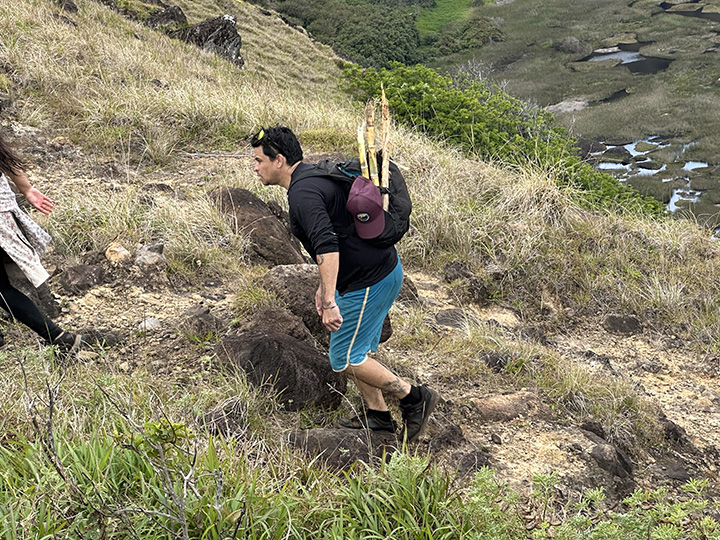
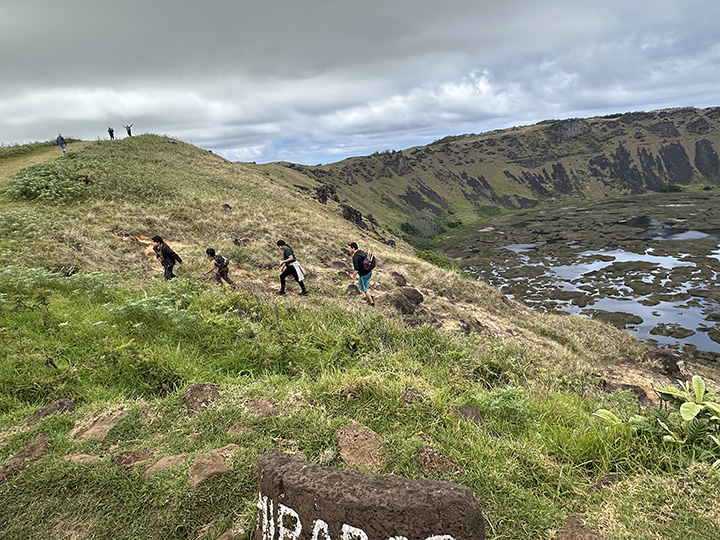
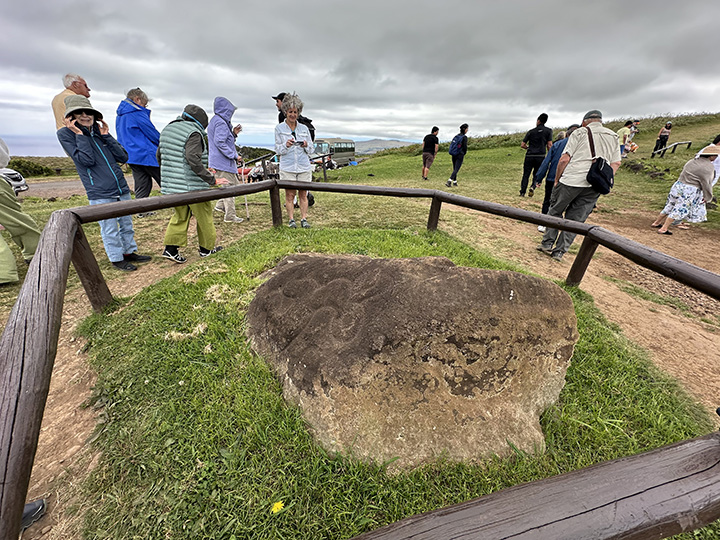
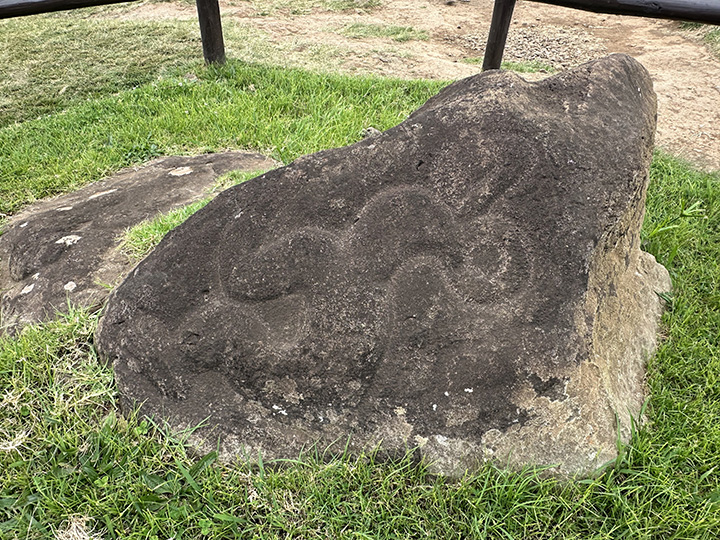
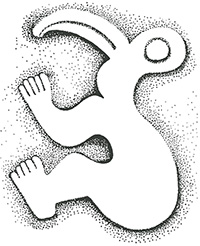 Here's
some
Here's
some